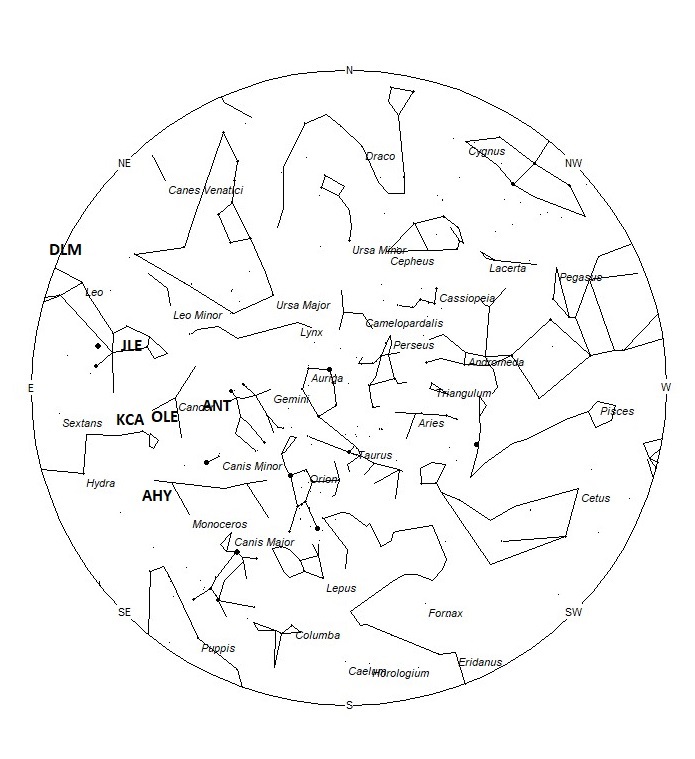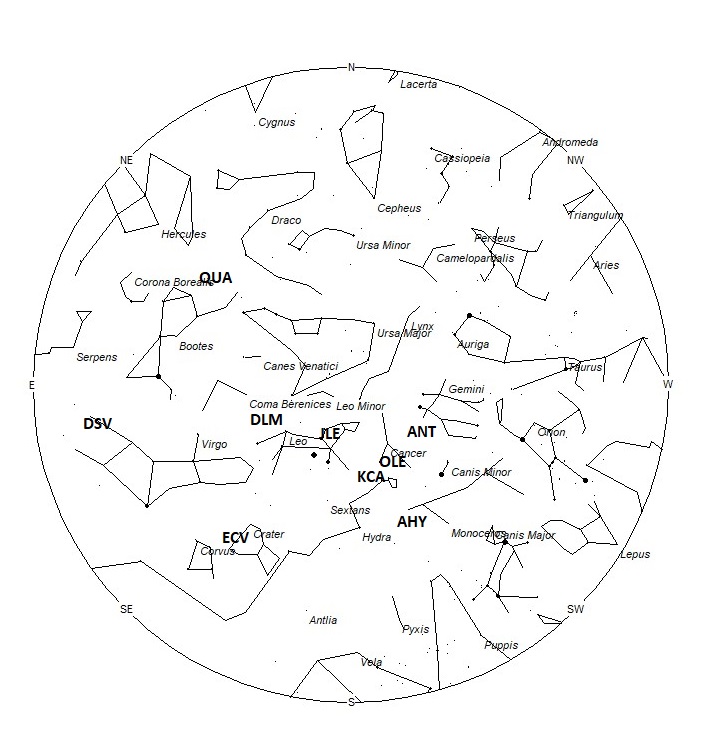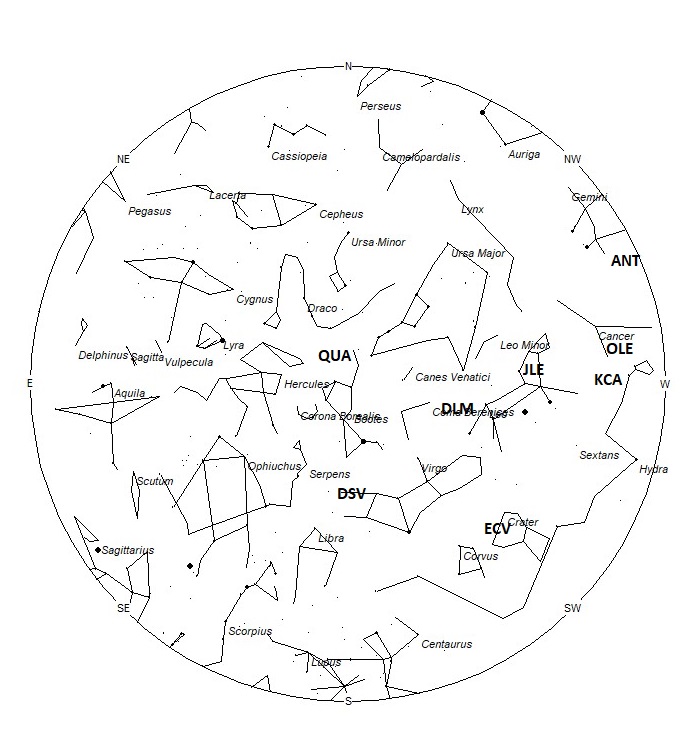
January is best known for the Quadrantids, which have the potential of being the best shower of the year. Unfortunately, this shower is short lived and occurs during some of the worst weather in the northern hemisphere. Due to the high northern declination (celestial latitude) and short summer nights, little of this activity can be seen south of the equator. There are many very minor showers active throughout the month. Unfortunately, most of these produce less than 1 shower member per hour and do not add much to the overall activity total. Activity gets interesting as seen from the southern hemisphere as ill-defined radiants in Vela, Carina, and Crux become active this month. This activity occurs during the entire first quarter of the year and moves eastward into Centaurus in February and ends in March with activity in Norma and Lupus. Sporadic rates are generally similar in both hemispheres this month. Sporadic rates are falling though for observers in the northern hemisphere and rising as seen from the southern hemisphere.
During this period, the moon reaches its last quarter phase on Wednesday January 6th. At this time, the moon is located 90 degrees west of the sun in the sky and will rise near midnight standard time. This weekend the waning gibbous moon will rise during the evening hours and will make it difficult to view any meteor activity the remainder of the night. The estimated total hourly meteor rates for evening observers this week is near 3 as seen from mid-northern latitudes and 2 as seen from tropical southern locations (25S). For morning observers, the estimated total hourly rates should be near 19 as seen from mid-northern latitudes (45N) and 5 as seen from tropical southern locations (25S). Meteor rates are reduced during this period due to moonlight. The actual rates will also depend on factors such as personal light and motion perception, local weather conditions, alertness, and experience in watching meteor activity. Note that the hourly rates listed below are estimates as viewed from dark sky sites away from urban light sources. Observers viewing from urban areas will see less activity as only the brighter meteors will be visible from such locations.
The radiant (the area of the sky where meteors appear to shoot from) positions and rates listed below are exact for Saturday night/Sunday morning January 2/3. These positions do not change greatly day to day so the listed coordinates may be used during this entire period. Most star atlases (available at science stores and planetariums) will provide maps with grid lines of the celestial coordinates so that you may find out exactly where these positions are located in the sky. A planisphere or computer planetarium program is also useful in showing the sky at any time of night on any date of the year. Activity from each radiant is best seen when it is positioned highest in the sky, either due north or south along the meridian, depending on your latitude. It must be remembered that meteor activity is rarely seen at the radiant position. Rather they shoot outwards from the radiant, so it is best to center your field of view so that the radiant lies at the edge and not the center. Viewing there will allow you to easily trace the path of each meteor back to the radiant (if it is a shower member) or in another direction if it is sporadic. Meteor activity is not seen from radiants that are located far below the horizon. The positions below are listed in a west to east manner in order of right ascension (celestial longitude). The positions listed first are located further west therefore are accessible earlier in the night while those listed further down the list rise later in the night.
These sources of meteoric activity are expected to be active this week.
.
The Anthelion (ANT) radiant is active from a position located at 07:40 (115) +21. This position lies in eastern Gemini, 8 degrees southwest of the 1st magnitude star known as Pollux (beta Geminorum). This radiant is a very large oval some thirty degrees wide by fifteen degrees high. Activity from this radiant can appear from more than one constellation., Anthelion activity may also appear from Cancer as well as Gemini. There are several lists that have the delta Cancrids currently active, but we include them with the Anthelions as the celestial positions overlap. The position listed here is for the center of the radiant. This radiant is best placed near 01:00 Local Standard Time (LST) when it lies on the meridian and is highest in the sky. Rates at this time should be near 2 per hour as seen from the northern hemisphere and 1 per hour as seen from south of the equator. With an entry velocity of 30 km/sec., the average Anthelion meteor would be of slow velocity.
The alpha Hydrids (AHY) were discovered by Dr. Peter Brown and are mentioned in his article “A meteoroid stream survey using the Canadian Meteor Orbit Radar”. This shower is active from December 16 through January 27 with maximum activity occurring on January 5th. The radiant is currently located at 08:26 (127) -08. This position lies in the western Hydra, 4 degrees south of the 4th magnitude star known as C Hydrae. These meteors are best seen near 0200 LST when the radiant lies highest above the horizon. At 44 km/sec. the alpha Hydrids produce meteors of medium velocity. Expected rates this week are less than 1 per hour no matter your location.
The Omicron Leonids (OLE) were discovered by Damir Šegon and the Croatian Meteor Network team based on studying SonotaCo and CMN observations (SonotaCo 2007-2011, CMN 2007-2010). These meteors are active from December 16 through February 4. Maximum activity occurs on January 9th. The radiant is currently located at 08:52 (133) +10. This position lies in southern Cancer, 2 degrees southwest of the 4th magnitude star known as Acubens (alpha Cancri). These meteors are best seen near 0200 LST when the radiant lies highest above the horizon. At 41 km/sec. the omicron Leonids produce meteors of medium velocity. Expected rates this week are less than 1 per hour no matter your location.
The kappa Cancrids (KCA) are not normally mentioned as a target for visual observers but during 2015 and 2016, activity has been noticed on video cameras that could be viewed by visual observers. These meteors are expected to be most active on January 9, near 15:59 Universal Time. This timing favors eastern Asia and the western Pacific area. The radiant is located at 09:12 (138) +09. This area of the sky lies approximately 5 degrees northeast of the “head” of Hydra. Nothing extraordinary is expected but any activity would be newsworthy. These meteors would most likely have a velocity of near 50 km/sec. and produce medium-fast meteors.
The January Leonids (JLE) were also discovered by Dr. Peter Brown and are mentioned in the same publication as the Alpha Hydrids. This shower is active from December 27 through January 11 with maximum activity occurring on January 2nd. The radiant is currently located at 09:53 (148) +24. This position lies in northwestern Leo, 2 degrees southeast of the 3rd magnitude star known as Algenubi (epsilon Leonis). These meteors are best seen near 0400 LST when the radiant lies highest above the horizon. At 59 km/sec. the January Leonids produce meteors of swift velocity. Expected rates this week are less than 1 no matter your location.
The December Leonis Minorids (DLM) are a shower of long duration active from November 22 through February 10th. Maximum occurred near December 20th. The radiant is currently located at 11:42 (176) +24. This position lies in northeastern Leo, 6 degrees northeast of the 3rd magnitude star known as Zosma (delta Leonis). These meteors are best seen near 0600 LST when the radiant lies highest above the horizon. Current hourly rates are expected to be less than 1 no matter your location. At 63 km/sec. the December Leonis Minorids produce mostly swift meteors.
The eta Corvids (ECV) were recently discovered by Sirko Molau and the IMO Video Meteor Network Team. This stream is active from January 16-29, with maximum activity occurring on the 22nd. The current position of the radiant is 11:44 (176) -15, which places the radiant in eastern carter, 4 degrees east of the 4th magnitude star known as Labrum (delta Crateris). These meteors are best seen near 0400 LST when the radiant lies highest above the horizon. Current hourly rates would be less than 1 per hour no matter your location. At 67 km/sec. these meteors would be fast.
The December sigma Virginids (DSV) is a source of long duration discovered by John Greaves using the data of SonotaCo. This source is active from November 22 through January 25. Peak rates occur near December 21st. The current radiant location is at 14:30 (217) +02 which places it in eastern Virgo, 3 degrees west of the faint star known as 109 Virginis. Current hourly rates should be less than 1 no matter your location. These meteors are best seen during the last dark hour before dawn, when the radiant lies highest above the horizon in a dark sky. At 66 km/sec. the December Sigma Virginids would produce mostly swift meteors.
The Quadrantids (QUA) are active from December 28th through January 7th. Maximum occurs on January 3rd near 14:30 Universal Time. The radiant is currently located at 15:20 (230) +50. This position lies in northern Bootes , roughly between 3rd magnitude Edasich (iota Draconis) and Nekkar (beta Boötis). 2nd magnitude Alkaid (eta Ursae Majoris), the bright star at the end of the Big Dipper’s handle, lies 25 degrees to the west. These meteors are best seen during the last hour before dawn when the radiant lies highest above the horizon in a dark sky. At 40 km/sec. the Quadrantids produce meteors of moderate velocity. These meteors are visible from the southern tropics but not seen from the deep southern hemisphere.
As seen from the mid-northern hemisphere (45N) one would expect to see approximately 6 sporadic meteors per hour during the last hour before dawn as seen from rural observing sites. Evening rates would be near 2 per hour. As seen from the tropical southern latitudes (25S), morning rates would be near 5 per hour as seen from rural observing sites and 1 per hour during the evening hours. Locations between these two extremes would see activity between the listed figures. Rates are reduced by moonlight during this period.
The list below offers the information from above in tabular form. Rates and positions are exact for Saturday night/Sunday morning except where noted in the shower descriptions.
| SHOWER | DATE OF MAXIMUM ACTIVITY | CELESTIAL POSITION | ENTRY VELOCITY | CULMINATION | HOURLY RATE | CLASS |
| RA (RA in Deg.) DEC | Km/Sec | Local Standard Time | North-South | |||
| Anthelion (ANT) | – | 07:40 (115) +21 | 30 | 01:00 | 2 – 1 | II |
| alpha Hydrids (AHY) | Jan 05 | 08:26 (127) -08 | 34 | 02:00 | <1 – <1 | IV |
| omicron Leonids (OLE) | Jan 09 | 08:52 (133) +10 | 41 | 02:00 | <1 – <1 | IV |
| kappa Cancrids (KCA) | Jan 09 | 09:12 (138) +09 | 50 | 03:00 | <1 – <1 | III |
| January Leonids (JLE) | Jan 02 | 09:53 (148) +24 | 59 | 04:00 | <1 – <1 | IV |
| December Leonis Minorids (DLM) | Dec 20 | 11:42 (176) +24 | 63 | 06:00 | 1 – <1 | II |
| eta Corvids (ECV) | Dec 22 | 11:44 (176) -15 | 67 | 06:00 | <1 – <1 | IV |
| December sigma Virginids (DSV) | Dec 21 | 14:30 (217) +02 | 66 | 09:00 | <1 – <1 | IV |
| Quadrantids (QUA) | Jan 03 | 15:20 (230) +50 | 40 | 10:00 | 10 – <1 | I |
 American Meteor Society
American Meteor Society


